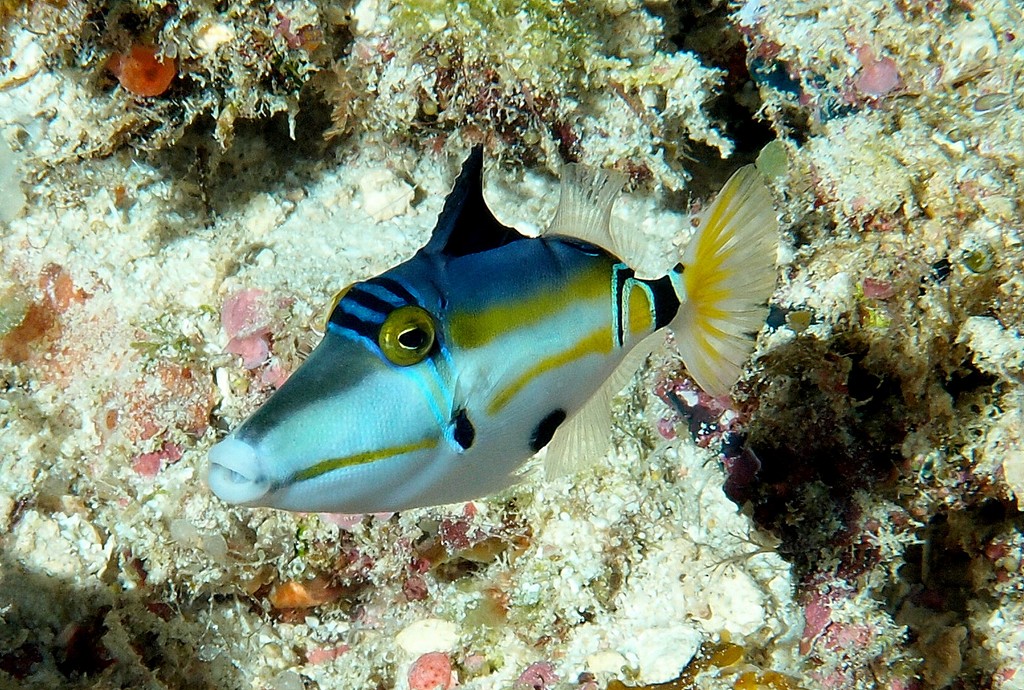RHINECANTHUS LUNULA - (RANDALL & STEENE, 1983)
Actinopterygii (Gigaclass) > Actinopteri (Class) > Teleostei (Subclass) > Tetraodontiformes (Order) > Balistoidei (Suborder) > Balistidae (Family) > Rhinecanthus (Genus)
Baliste picasso demi-lune, Baliste à queue cerclée, Cresent triggerfish, Halfmoon picassofish, Lunula triggerfish, Halvmåne picassofisk, 月銼鱗魨,
Description
Dorsal spines (total): 3; Dorsal soft rays (total): 25-26 (usually: 26); Anal soft rays: 22-24; Pectoral fin rays: 14; Snout long: 2.7-2.8 in SL; Caudal peduncle slender; Three horizontal row of small forward-curving spines posteriorly on body, the upper row ending at front of caudal peduncle, the lower tow extending to caudal-fin base; Caudal fin slightly double emarginate. Max. length: 28.0 cm TL. Depth range: 10 - 40 m.
Color
Yellowish grey on back, shading to white ventrally, with a large blackish area on lower side centred above anus; A broad blue-edged black bar across caudal peduncle with a curved blue band containing a black line interspaces across interorbital, continuing as three blue bands to pectoral base; A blue and yellow line at base of upper lip, the yellow continuing as a narrow band nearly to pectoral base; Anus in a black spot; A black crescent in caudal fin preceded by a yellow area; First dorsal fin black; Juveniles lack the black caudal crescent and large blackish area on lower side.
Etymology
Rhinecanthus: from Greek, rhine = rasp + from Greek, acanthus = thorn or spine. Proposed as a subgenus of Balistes with a rough, instead of smooth, first dorsal-fin spine.
lunula: from Latin, lunula = something shaped like a crescent or half-moon. Referring to large crescentic mark (black in adults, yellow in juveniles) on caudal fin.
Baliste picasso demi-lune, Baliste à queue cerclée, Cresent triggerfish, Halfmoon picassofish, Lunula triggerfish, Halvmåne picassofisk, 月銼鱗魨,
Description
Dorsal spines (total): 3; Dorsal soft rays (total): 25-26 (usually: 26); Anal soft rays: 22-24; Pectoral fin rays: 14; Snout long: 2.7-2.8 in SL; Caudal peduncle slender; Three horizontal row of small forward-curving spines posteriorly on body, the upper row ending at front of caudal peduncle, the lower tow extending to caudal-fin base; Caudal fin slightly double emarginate. Max. length: 28.0 cm TL. Depth range: 10 - 40 m.
Color
Yellowish grey on back, shading to white ventrally, with a large blackish area on lower side centred above anus; A broad blue-edged black bar across caudal peduncle with a curved blue band containing a black line interspaces across interorbital, continuing as three blue bands to pectoral base; A blue and yellow line at base of upper lip, the yellow continuing as a narrow band nearly to pectoral base; Anus in a black spot; A black crescent in caudal fin preceded by a yellow area; First dorsal fin black; Juveniles lack the black caudal crescent and large blackish area on lower side.
Etymology
Rhinecanthus: from Greek, rhine = rasp + from Greek, acanthus = thorn or spine. Proposed as a subgenus of Balistes with a rough, instead of smooth, first dorsal-fin spine.
lunula: from Latin, lunula = something shaped like a crescent or half-moon. Referring to large crescentic mark (black in adults, yellow in juveniles) on caudal fin.
Original descritpion: Rhinecanthus lunula Randall & Steene, 1983 - Type locality: Outside barrier reef about 1/4 mile east of Teavaraa Pass, Papara, Tahiti, Society Islands, depth 15 meters.
Distribution
Distribution
Southwestern Pacific, South Pacific: Queensland (Australia), New Caledonia, east to Pitcairn Island.
Biology
A rare species that lives in outer reef areas. Feeds on fishes, benthic invertebrates, algae and organic matter.
A rare species that lives in outer reef areas. Feeds on fishes, benthic invertebrates, algae and organic matter.
Last update: 27, March 2023
